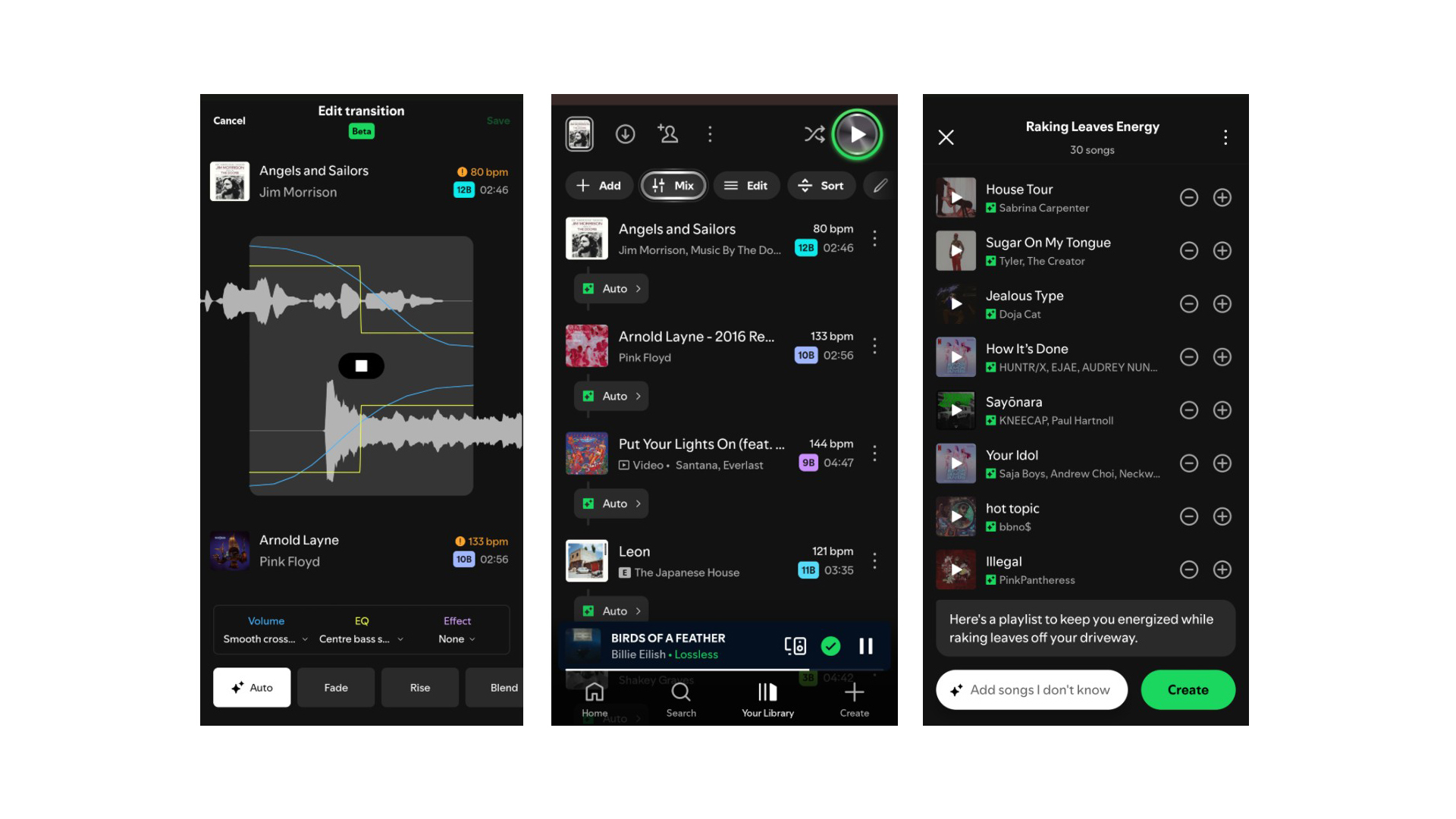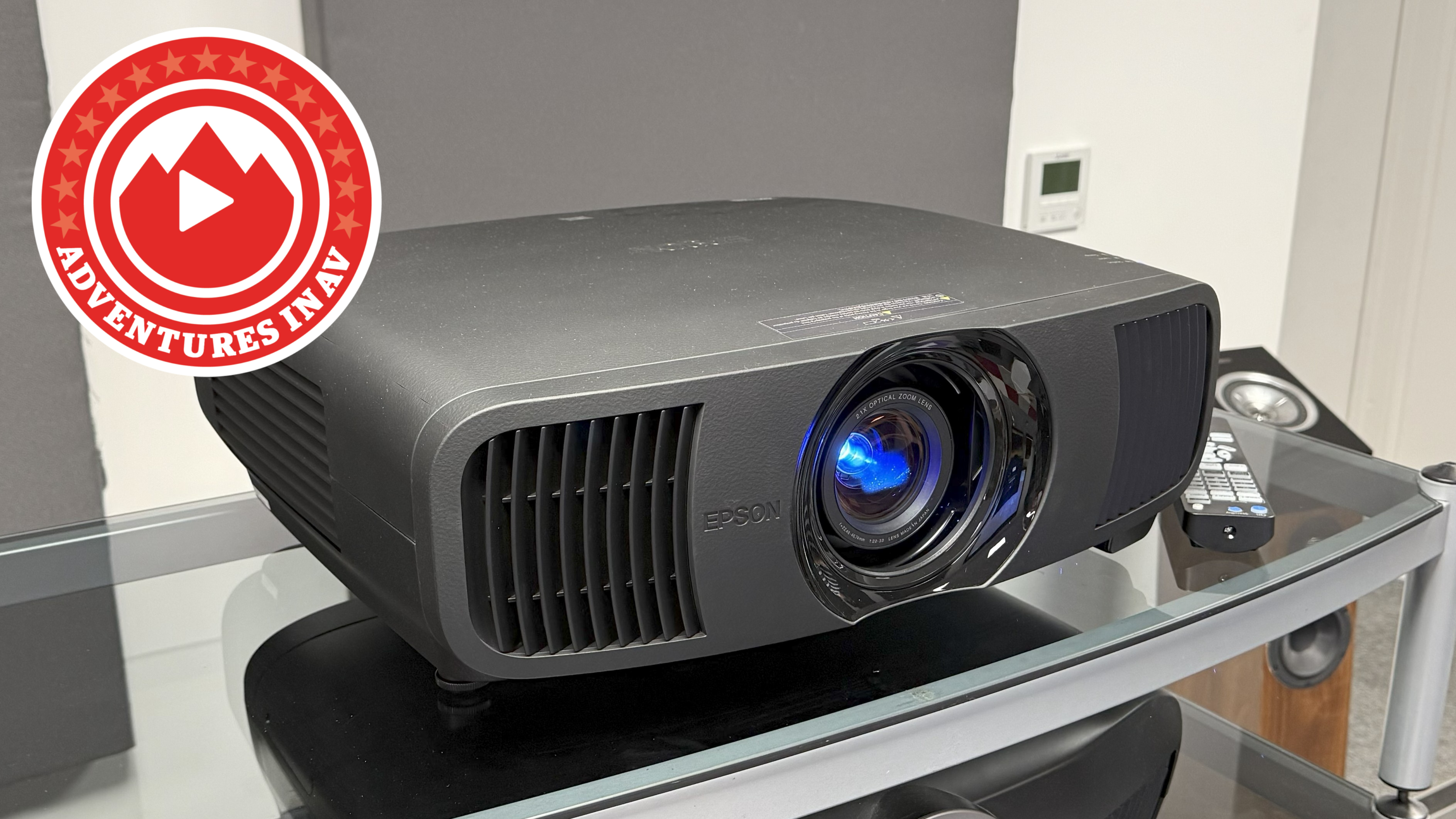What Hi-Fi? Verdict
The long-anticipated arrival of hi-res streaming plugs the only gaping hole in Spotify’s offering, making it an ideal choice for most people – just not for those who prioritise sound quality above all else
Pros
- +
Hi-res streaming
- +
Newly improved free tier
- +
Exemplary interface
- +
Exhaustive discovery and personalisation features
- +
Unique audiobook/podcast offering
Cons
- -
Rivals offer higher audio quality still
- -
No spatial audio support
Why you can trust What Hi-Fi?
The world’s most popular music streaming service was somewhat left behind in 2021. While rivals Apple Music and Amazon Music significantly upgraded their catalogues’ audio quality to 24-bit hi-res, all loyal Spotify subscribers could do was watch helplessly on, as the service’s promise to improve its own, lowly 320kbps library failed to materialise. (The non-loyal subscribers? They jumped ship.) This went on for four years.
Sure, Spotify continued to pioneer the streaming experience during that time with innovative discovery features, its milestone addition and growth of audiobooks and podcasts, and the pop culture hit Spotify Wrapped playlist – and had market-leading subscriber numbers to show for it.
But that agonising wait for higher-quality audio, plus a string of price hikes that made it one of the most expensive options out there, ultimately saw its value wane next to the better-sounding competition. We had no other choice but to drop Spotify’s long-held five-star What Hi-Fi? review to a four-star one.
In September 2025, however, better-quality audio finally came to fruition as Spotify Lossless, giving Premium subscribers 24-bit hi-res audio for no extra cost. Undoubtedly forced into a corner by its rivals doing the same thing in 2021, the company went beyond its initial promise to offer ‘only’ 16-bit CD-quality streams. Hurrah!
Now, Tidal has been our favourite music streaming service for the past decade, having won our What Hi-Fi? Award since 2014, the year it launched with a CD-quality catalogue. (If that doesn’t put Spotify’s tardiness on the audio quality front into perspective, we don’t know what does.)
But with the arrival of much-improved sound quality now completing what is an otherwise near-faultless streaming offering, can Spotify regain that title for the first time since 2013? We’ve re-reviewed Spotify, comparing it with its rivals today, in search of the answer.
Price
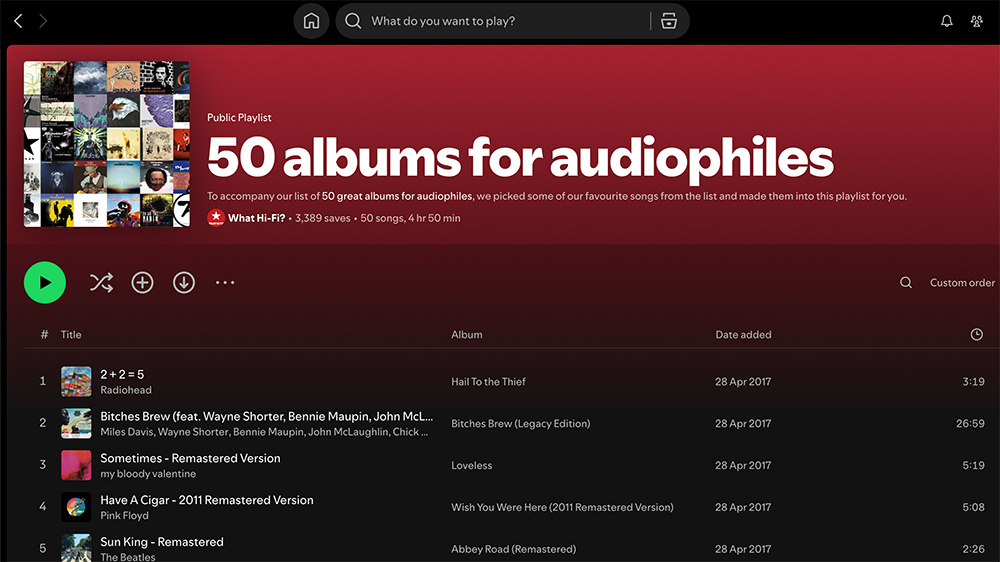
Alongside Deezer and YouTube Music, Spotify is one of the few streaming services today that offers a free tier, allowing you to listen to millions of songs without spending a dime.
The latest hi-fi, home cinema and tech news, reviews, buying advice and deals, direct to your inbox.
Naturally, this tier has caveats – audio quality is capped at 128kbps on its web player and approximately 160kbps on its desktop, mobile and tablet apps; you can’t ‘download’ songs to listen to offline; and – the big one – you have to tolerate adverts popping up between every few songs.
While Spotify Free also limited user playback control by predominantly offering a song-shuffling experience since its refresh in 2018, as of September 2025 it now allows listeners to pick and search for specific songs, while also allowing them to access songs shared with them over social media straight away. This is a massive boon for Spotify Free listeners.
The paid-for Premium tier, which around 40 per cent of Spotify’s near-700 million users subscribe to, scraps those aforementioned limitations while delivering more features.
Catalogue 100+ million
Sound quality Up to 24-bit/44.1kHz
File formats FLAC, Ogg Vorbis, AAC
Platforms iOS and Android mobile apps, desktop app, web player
The audio quality cap is significantly higher now that Spotify has, after a four-year delay, introduced Lossless for hi-res listening up to 24-bit/44.1kHz in FLAC quality. Spotify Connect allows Premium subscribers to cast the catalogue directly to the vast majority of wi-fi-enabled speakers, TVs and audio systems available today. And also included is 15 hours of audiobook listening per month, which can be expanded for an additional cost.
Spotify has also recently gone pretty heavily into personalisation and AI functions that allow subscribers to, for example, add transitional effects between songs, create their own playlist cover art, and generate their own AI-curated playlist simply by typing in their genre and mood or other prompts.
So what does Premium cost? You have a few options. A standard individual Premium subscription sets you back £11.99 / $11.99 / AU$15.99 per month, while a student subscription is available for £5.99 / $5.99 / AU$7.99.
Even better value is Spotify Duo, which gives two people living under one roof Premium accounts for £16.99 / $16.99 / AU$22.99. Want Spotify for everyone in the household? Premium Family gives Premium (or child-friendly and parent-controlled Kids) accounts to up to six people for £19.99 / $19.99 / AU$27.99 per month.
Spotify prices had remained static for a long time, but mounting legislative and market pressures have caused them to increase multiple times in recent years across various markets internationally.
Spotify’s paid-for Premium subscriptions are therefore more expensive than those of its closest competitors. Apple Music, Amazon Music and Tidal charge £10.99 / $10.99 / AU$12.99 per month for their Individual plans, for example, with their Family plans similarly undercutting Spotify’s. Only Qobuz sits above it with a £12.99 / $12.99 / AU$19.99 subscription.
Catalogue
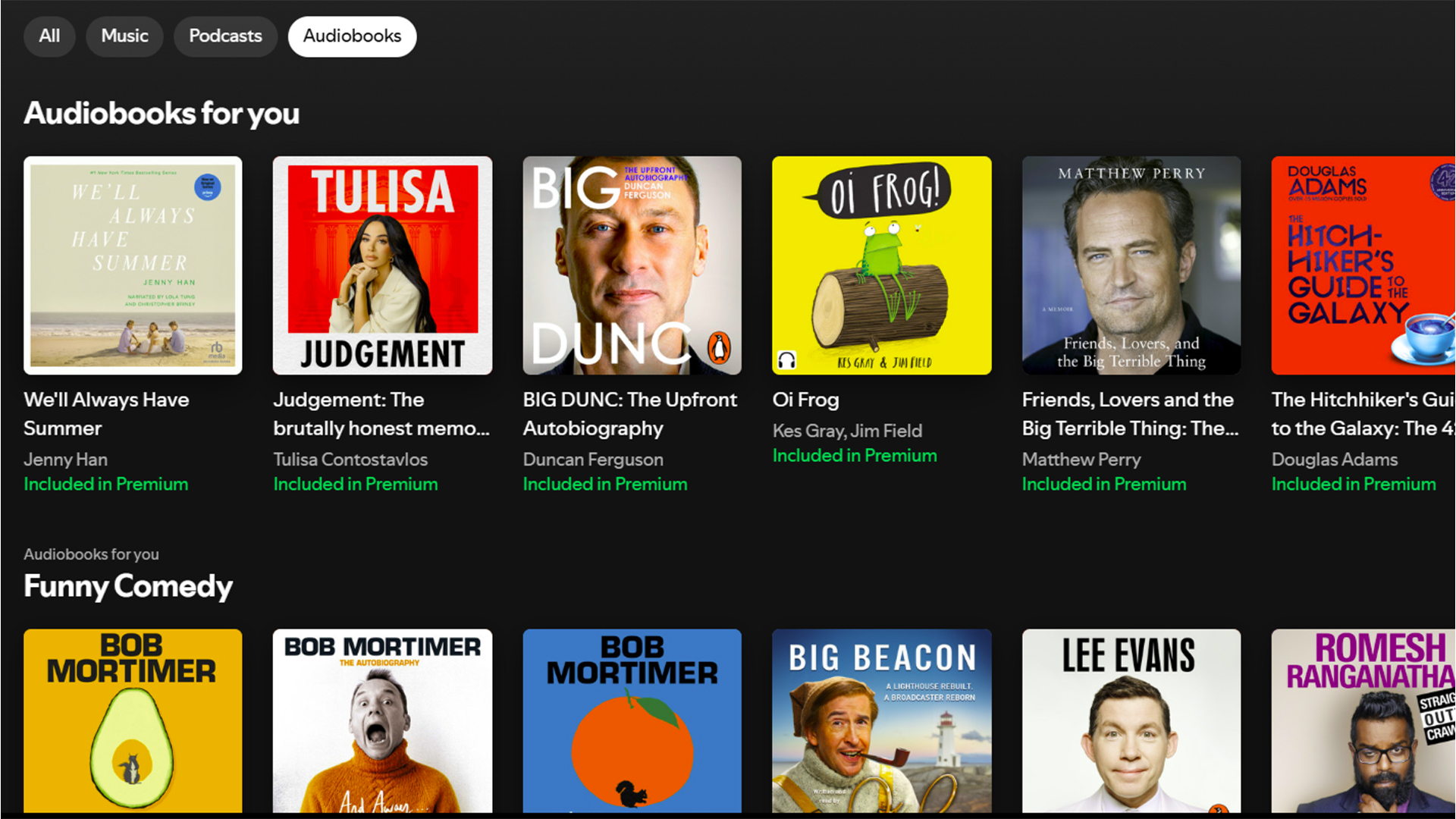
The immensity of Spotify’s catalogue has historically won the service points for being the world’s biggest. A decade ago, its song library was 30-million strong, but today that figure is, according to the service, "over 100 million".
There’s more or less parity when it comes to the catalogue size of the major services these days, though – that figure (or "over 110 million" if you’re Tidal) is commonly quoted, essentially meaning that they all deliver choice overload, and then some.
Where Spotify’s catalogue stands out from its rivals’ is in its podcast and audiobook offerings, which are significantly more comprehensive and integrated. Tidal doesn’t offer such sections, while Apple has separate Podcasts and Books apps instead, for example.
Since the acquisition of podcasting production specialist Gimlet Media in 2019, “nearly 7 million podcast titles” have been made available to stream and download on Spotify, including a raft of original content, with big names such as Joe Rogan, Amy Poehler, Alex Cooper and Ben Shapiro appearing in the US Podcast Chart at the time of writing.
Many hits were initially exclusive to Spotify, although recently the service has pivoted away from exclusivity to license them out to other platforms and grow ad revenue.
For audiobookworms, there are 350,000 to tuck into. Again, Premium users get 15 hours of listening time with their plan, with the Audiobooks+ plan doubling that time for £8.99 / $11.99 / AU$12.99 extra per month, or 10-hour top-ups available for £9.99 / $12.99 / AU$15.99.
Features & user experience
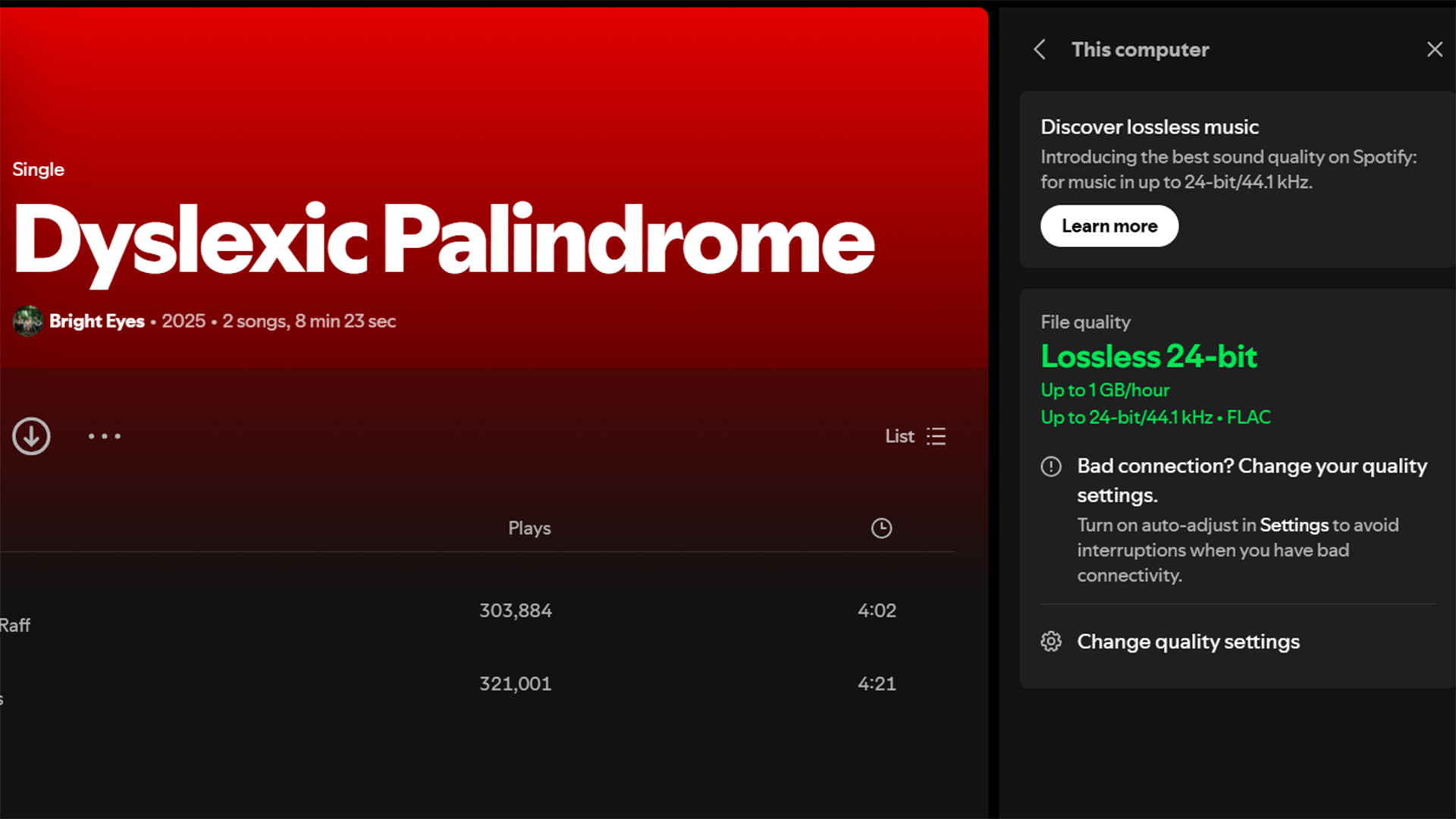
Another traditionally gleaming jewel in Spotify’s crown has been its interface and user experience across its mobile, tablet and desktop apps and web player.
Competitors have made headway in these areas in recent years, with AI-powered curations, artist-based ‘radio station’ mixes and somewhat homogenised layouts pretty much a given, yet the green streaming giant still edges ahead here.
The well laid-out Search section (or Browse on desktop/web) complements that all-important search bar with shortcuts to Music, Podcasts, Audiobooks, (local) Live Events, Videos and (learning) Courses suggestions, as well as more granular shortcuts based on music genre (Indie, K-pop etc), your current activity (Workout, Cooking & Dining) and popular Spotify curations (New Releases, Charts).
Your Library is where you can access saved playlists, artists and podcasts, while Create is all about building playlists and sharing music with others. You can create a playlist in collaboration with your Spotify-using friends, blend their tastes into a playlist, or invite them to help you build a shared song queue.
You can also ask Spotify to curate an AI Playlist based on your prompt, which can be as simple as ‘give me some music similar to my top artist’ or as out there as ‘make me a playlist for raking leaves off my driveway’.
With the latter, a ‘Raking Leaves Energy’ playlist was created in moments to keep me ‘energized’, suitably featuring Doja Cat, Lady Gaga and Tyler, The Creator… although really we were after autumnal tracks perfect for the UK weather.
We went back to add ‘autumnal’ to the prompt and up came Suede, Hayley Williams, Mazzy Star and The Mountain Goats, among others. Much better, although we would’ve preferred fewer doubling (and even tripling) up of artists. A (fun!) work in progress, then.
Also logically organised, the Home page is where you'll find your current favourites and most played, as well as assorted, algorithm-led curations (such as ‘Picked for you’ and ‘Made For’) based on your listening habits.
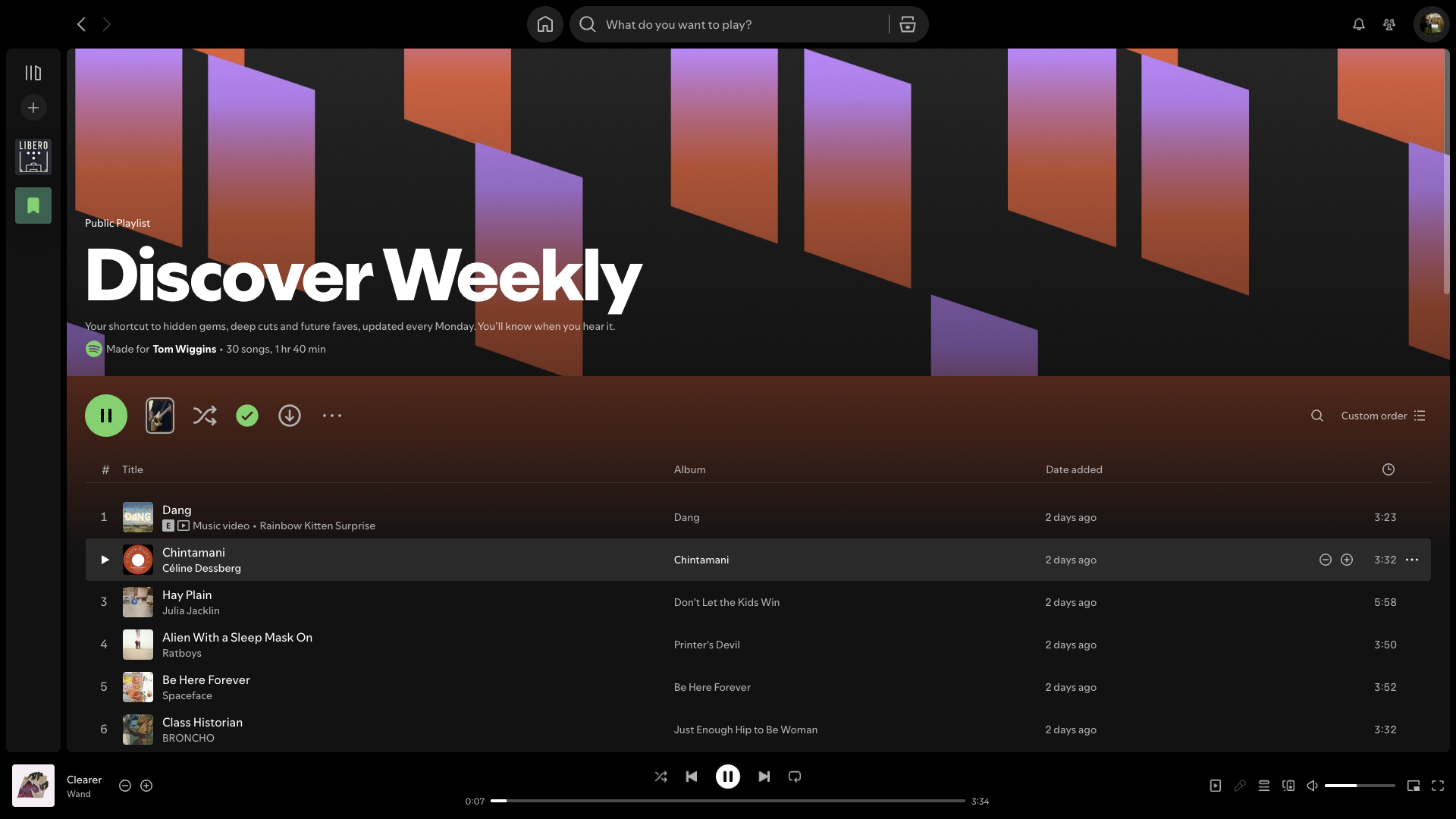
Whereas Spotify (and other services) once used algorithmic skills to suggest specific tracks or albums, recommendations have since evolved to increasingly take the form of categorised mixes. Of them, music discovery mixes such as the ‘Discover Weekly’ and ‘Release Radar’ headliners remain at the forefront of the Spotify experience and are arguably where the service still just about gains ground on its rivals.
Generally, such playlists are pretty spot-on, offering a good mix of both old and new, and even including new remixes of songs from artists you have listened to. The more we listen, the more they evolve; and the more we discover, the more we thank our lucky stars that such algorithmic ingenuity has advanced since Spotify’s pioneering efforts.
Spotify’s ‘Wrapped’, which every December invites users to view a montage of data about their year’s listening activity and share it on social media, is another of the service’s masterstrokes in the streaming space.
Now that hi-res quality has been added, the only real gap in Spotify’s feature offering is spatial audio. While Tidal, Apple Music and Amazon Music offer Dolby Atmos-powered songs and experiences for ‘immersive’ listening that aims to open up the soundfield beyond the confines of a traditional stereo image, taking particular advantage of songs that have been specifically produced or remixed in Atmos, Spotify seems to be ignoring the buzzy audio technology completely.
As we generally find spatial audio mixes hit and miss, we don’t believe the omission is a deal-breaker. But we can imagine fans of (and those intrigued by) the tech understandably being disappointed by it.
Ultimately, Spotify is highly impressive when it comes to music discovery, catalogue and user experience. It’s little wonder that many competing services have come and gone in the 17 years Spotify has been around, but even those alive and kicking today don’t quite match Spotify’s level of completeness.
Sound quality
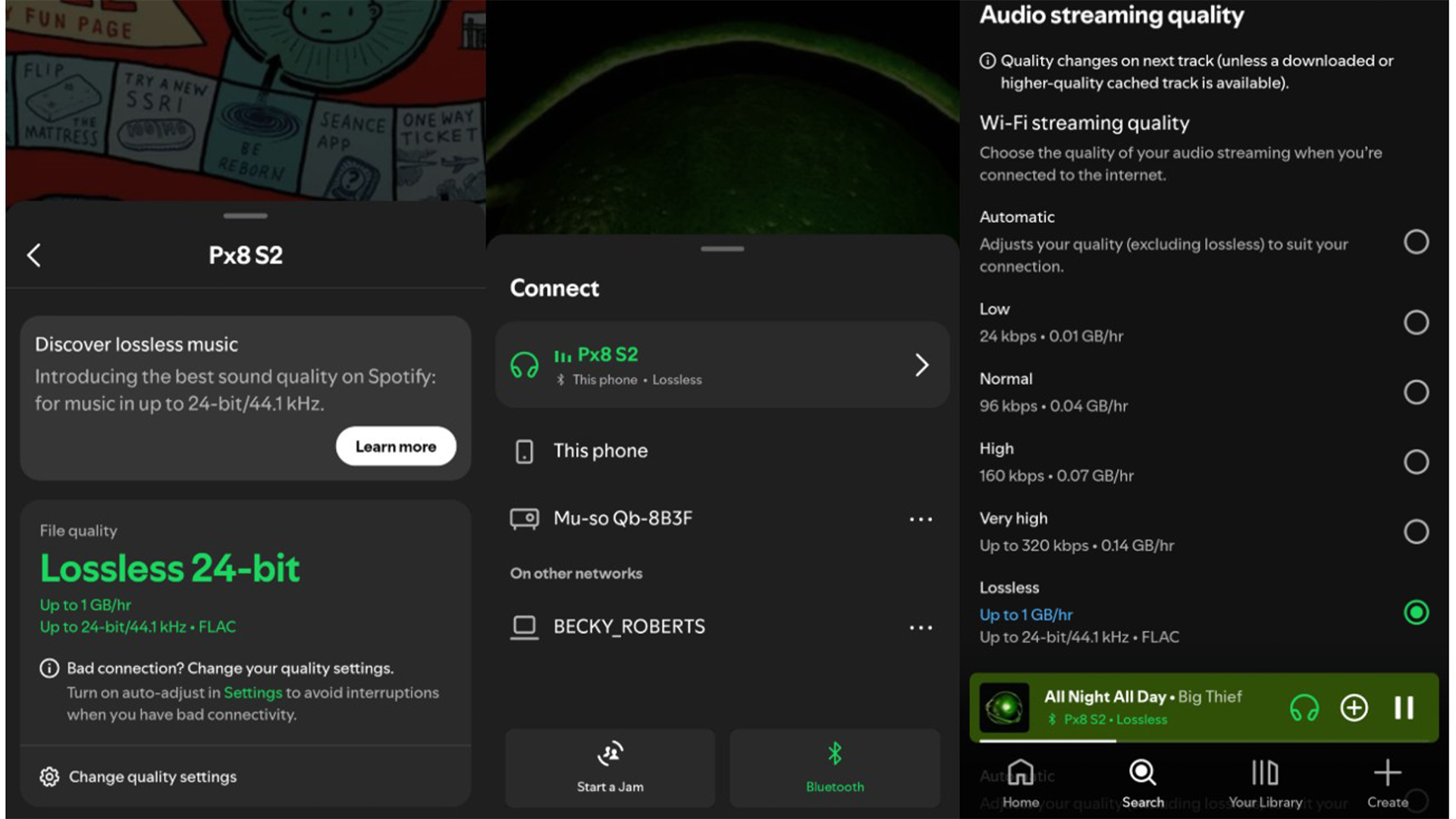
How Spotify streams sound is the single biggest area of improvement in years, with the introduction of Spotify Lossless taking the service’s peak audio quality from 320kbps to over 2000kbps (24-bit/44.1kHz). This can be taken advantage of in the Spotify desktop and mobile apps, and over Spotify Connect with compatible products.
This is a significant upgrade – a read of our hi-res audio explainer will illustrate to you the technical magnitude between these compressed (lossy) and uncompressed (lossless) audio qualities, respectively – and indeed one that can be heard.
For our testing, we use a range of premium wireless earbuds and headphones (connected to an Android phone either wirelessly via Bluetooth or wired with a USB-C cable) as well as a high-end wired headphones/DAC combo connected to a laptop.
We stream several songs in the two qualities from the Spotify mobile and desktop apps, and the Lossless streams are notably more involving. They’re clearer, punchier and more open and detailed, generally sounding less congested and messy than the 320kbps version too.
The difference is night and day, even when listening wirelessly through the least premium Bluetooth headphones we tried (the Bose QC Ultra Earbuds 2nd Gen), which is good news considering that everyday wireless headphones are what many people use to listen to Spotify.
If that includes you, it’s worth knowing that even the most efficient Bluetooth technology typically found in consumer electronic devices compresses music in order to transmit it wirelessly, and therefore isn’t lossless. So if you’re listening to Spotify (or any streaming service) wirelessly over Bluetooth headphones or speakers, you won’t get uncompressed 24-bit streams and won’t be taking full advantage of the lossless quality on offer.
So far, so good. But how does Spotify now sound compared to Tidal? It’s difficult to compare any music streaming service against another exactly like for like, as there is no way we can check whether even the same songs found on both services are taken from the same master recording.
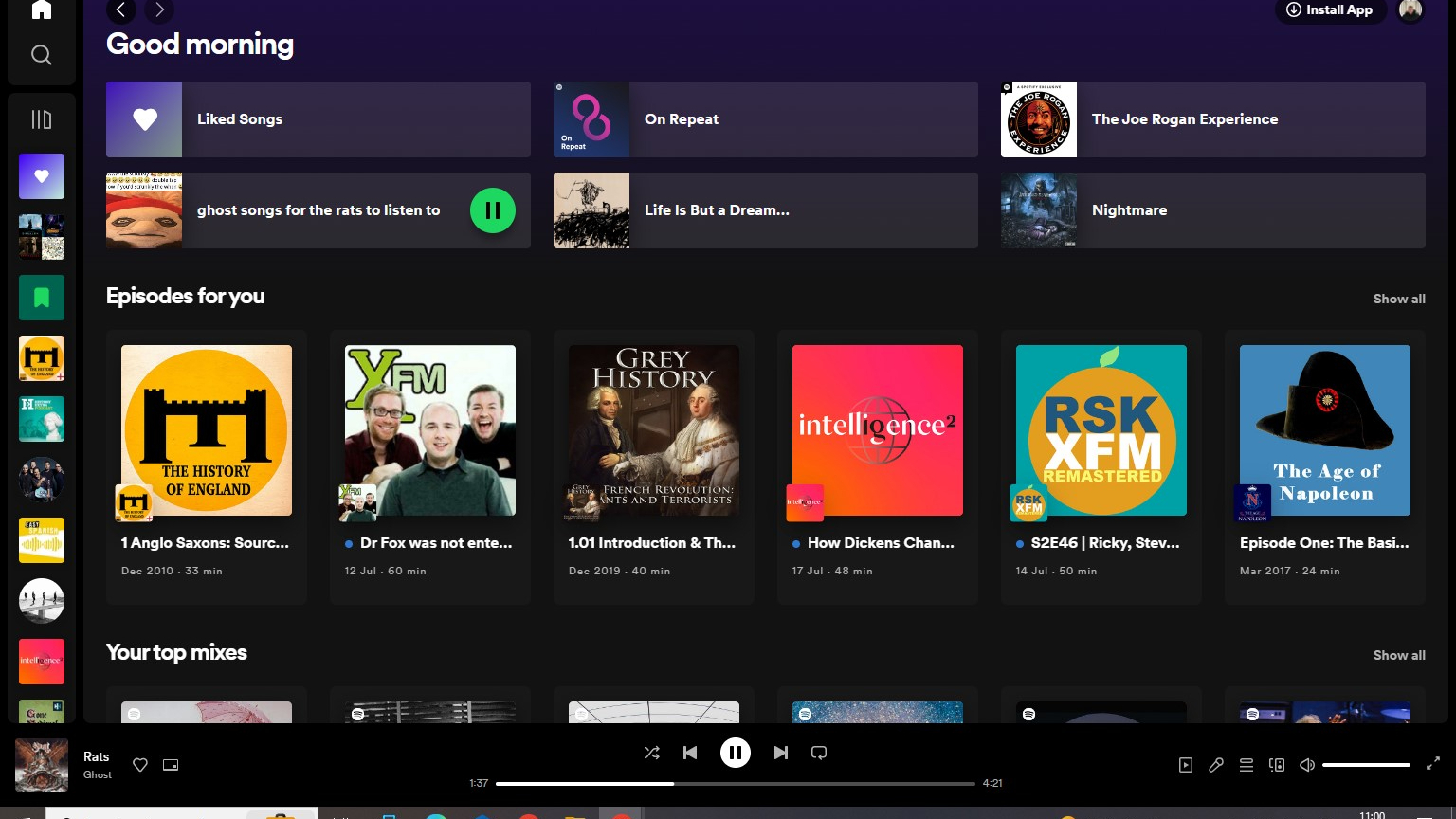
However, from the 20+ tracks we played (mostly 16-bit/44.1kHz, with some 24-bit/44.1kHz too), the Tidal streams generally sounded that bit clearer, fuller and more refined. As an example, we tee up Big Thief’s All Night All Day (16-bit/44.1kHz) and immediately hear greater texture in the shaker and drumbeat opening. We’re more drawn into the dense jingle-jangly instrumentation, and captivated by the extra layer of Andrienne Lenker’s vocal that surfaces.
Tidal not only edges it for songs with the same bitrates but is also capable of playing higher bitrates. Indeed, the elephant in this section of our review, for audiophiles at least, is that Spotify’s new quality ceiling of 24-bit/44.1kHz compares unfavourably to the 24-bit/192kHz upper limit of Tidal and every other hi-res streaming service. So have we really waited four years for Spotify to fall short of the competition still?
Unfortunately, yes, and that will rightfully bother Spotify Premium subscribers who stream through high-end headphones or hi-fi systems that are transparent enough to reveal the extra detail in those higher-quality streams, such as our Chord Hugo 2 DAC feeding a reference pair of Grado headphones.
We play Toto’s We Made It through the set-up on both services, and the 192kHz Tidal stream reveals the sonic benefit at least in part brought by the higher bitrate. It’s an even better advert for the track’s radiant, squeaky clean production – more instrumental texture is eked out while the interplay between the slicing cymbals, jaunty piano and potent bass note is rhythmically tighter.
Why the 44.1kHz limit then, Spotify? According to one of its engineering managers, as discussed in a Reddit AMA, Spotify recognised that supporting full hi-res audio would offer “greater objective precision”, but also stated that facilitating it would require “greater data volume and bandwidth requirements” across its “user base of hundreds of millions”.
They then continued to say that “the difference between audio quality settings can be very subtle and hard to detect for most people”. So Spotify’s decision to impose a 44.1kHz ceiling seems to logically come from having weighed the extra practical and technical considerations against what will satisfy most subscribers, even if that will understandably irk the niche number of subscribers who could benefit from a higher one.
Verdict
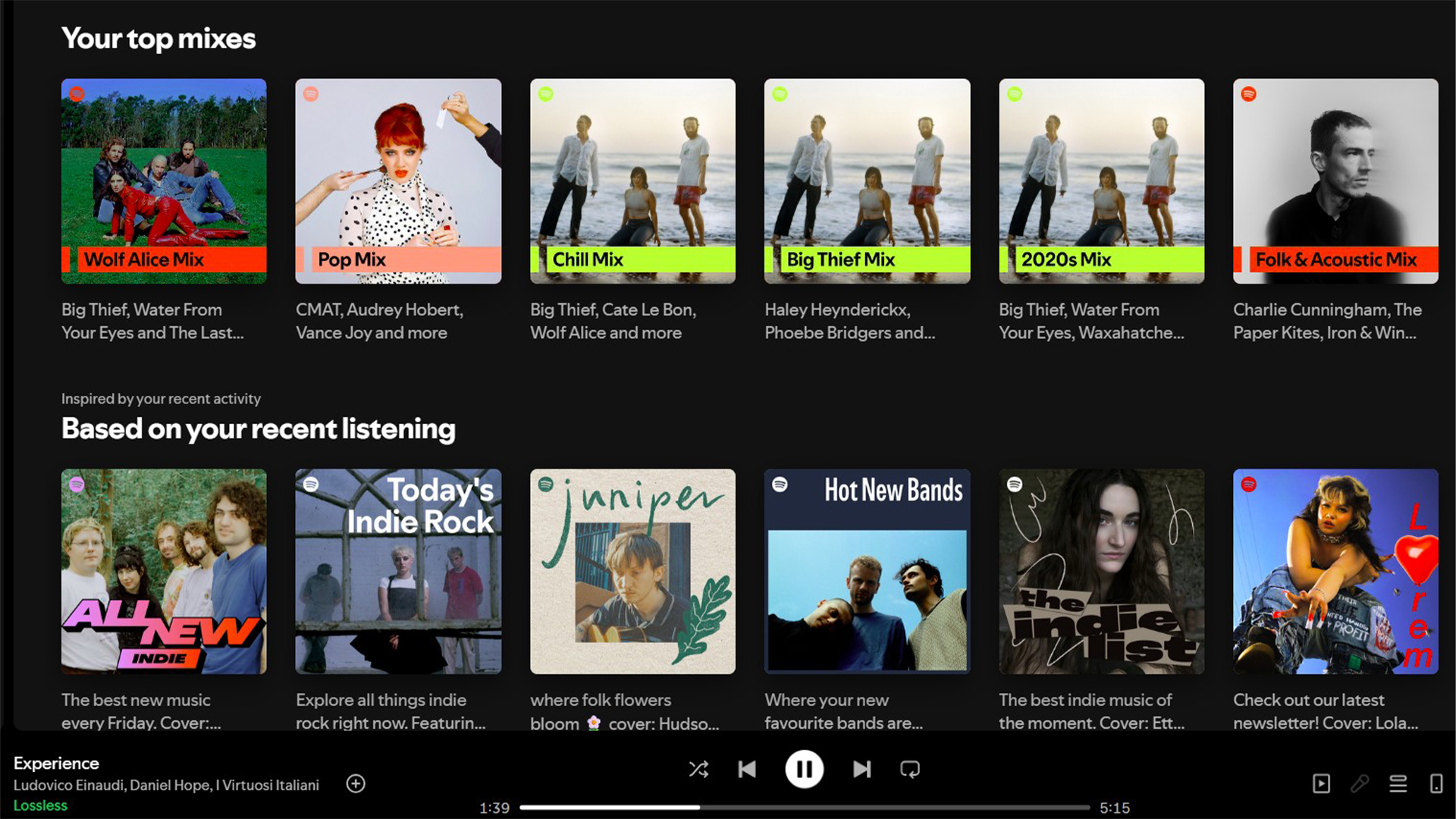
It’s easy to see why Spotify remains the mass market choice. With a uniquely vast audiobook and podcast offering, the option of an accessible-to-all free tier, an edge when it comes to discovery, curation and personalisation features, and an expansive music catalogue that now offers much-improved audio quality, Spotify will indeed be the most complete and ideal music streaming service for most people.
The new Lossless streams have narrowed the monumental gap in audio quality between Spotify and its rivals that has existed for years, while the recent focus on audiobooks and podcasts gives the service yet another strong string to its bow.
However, there are reasons to look elsewhere aside from questions around artist pay-outs and other political reasons that have cropped up in recent years. It’s a tad more expensive, for one, and other hi-res services may offer usability that better fits their equipment or preference, for another.
More importantly, those who prioritise sound quality, particularly those who own sophisticated audio hardware, will ultimately still be better served by Tidal and others that sit ahead of Spotify in the sound-prioritising pack.
Review published: 29th September 2025
SCORES
- Sound 4
- Features 5
- Ease of use 5
MORE:
Read our Tidal review
Also consider Apple Music
Read our review of Qobuz
Here's our rundown of the best music streaming services available right now
How to cancel Spotify Premium – and should you?

Becky is a hi-fi, AV and technology journalist, formerly the Managing Editor at What Hi-Fi? and Editor of Australian Hi-Fi and Audio Esoterica magazines. With over twelve years of journalism experience in the hi-fi industry, she has reviewed all manner of audio gear, from budget amplifiers to high-end speakers, and particularly specialises in headphones and head-fi devices.
In her spare time, Becky can often be found running, watching Liverpool FC and horror movies, and hunting for gluten-free cake.
- Ketan BharadiaTechnical Editor
You must confirm your public display name before commenting
Please logout and then login again, you will then be prompted to enter your display name.
